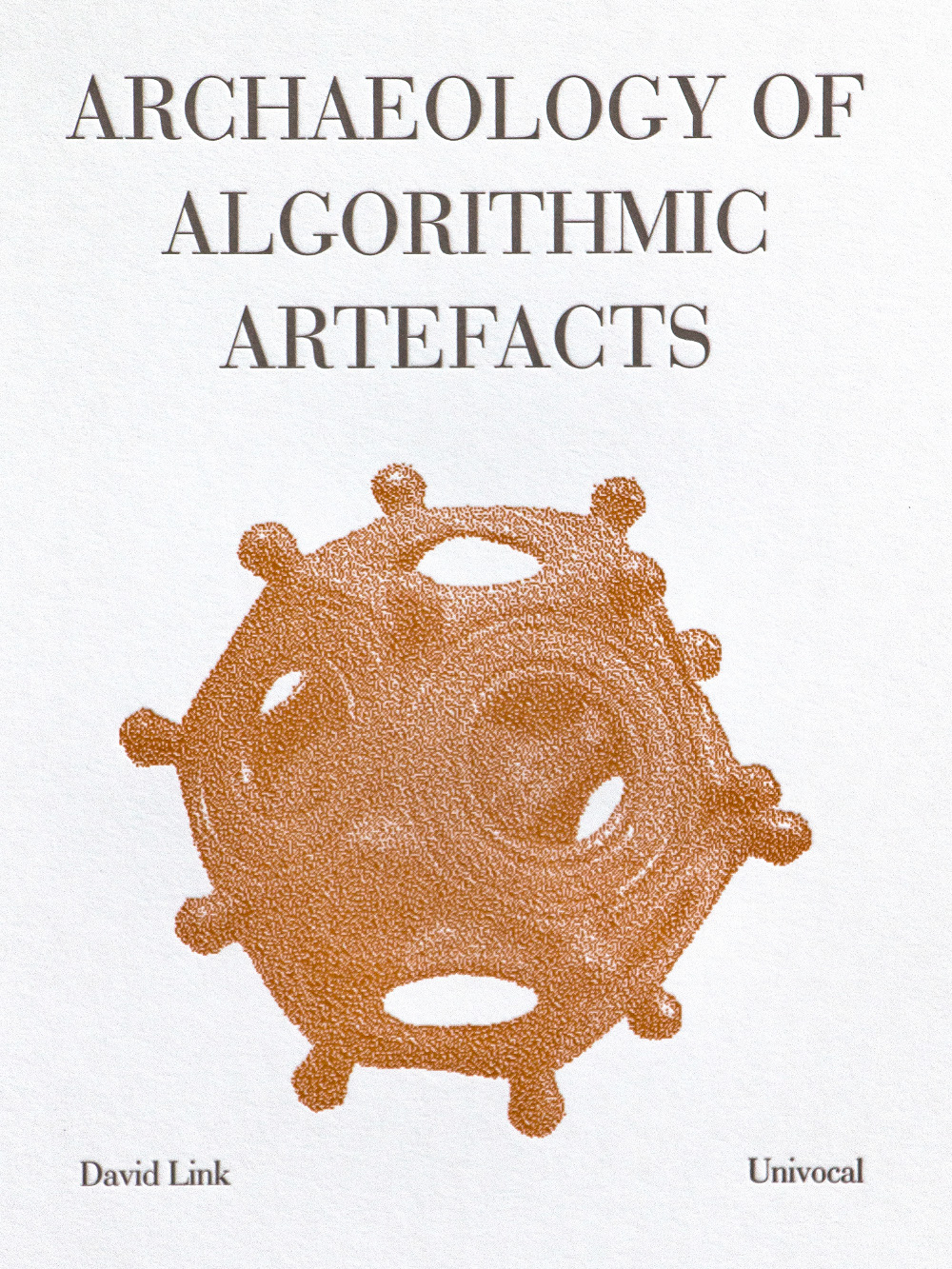David Link: Archaeology of Algorithmic Artefacts (2016)
Filed under book | Tags: · algorithm, apparatus, computing, history of computing, machine, mathematics, media archeology, theory

“Unearthing the cumulus of transient technologies that underlie the fabric of contemporary society
As historical processes increasingly become steeped in technology, it becomes more and more necessary for a discipline to emerge that is capable of comprehending these materialities beyond their shelf life to better understand the fields they inundate such as science, art, and warfare. This effort is further compromised by the inherent complexity and complete arbitrariness of technical languages – especially when they are algorithmic – along with the rapid pace in which they become obsolete, unintelligible, or simply forgotten. The Turing Machine plays a central role in the Archaeology of Algorithmic Artefacts, wherein the gradual developments of the individual components encompassed by this complex technology are placed within the context of engineering sciences and the history of inventions. This genealogy also traces the origin of the computer in disciplines such as mathematics, meta-mathematics, combinatorics, cryptology, philosophy, and physics. The investigations reveal that the history of apparatuses that process signs is in no way limited, as one might think, to the second half of the 20th century, rather it is possible that they existed at all times and in all cultures.”
Publisher Univocal Publishing, Minneapolis, 2016
ISBN 9781937561048, 1937561046
207 pages
Review: Lisa Gitelman (Computational Culture, 2017).
PDF (18 MB)
Comments (3)Isabelle Stengers: The Invention of Modern Science (1993–) [EN, PT]
Filed under book | Tags: · apparatus, epistemology, event, fact, fiction, history of science, mathematics, philosophy of science, physics, politics, science, sociology, theory, truth

The so-called exact sciences have always claimed to be different from other forms of knowledge. How are we to evaluate this assertion? Should we try to identify the criteria that seem to justify it? Or, following the new model of the social study of the sciences, should we view it as a simple belief? The Invention of Modern Science proposes a fruitful way of going beyond these apparently irreconcilable positions, that science is either “objective” or “socially constructed.” Instead, suggests Isabelle Stengers, one of the most important and influential philosophers of science in Europe, we might understand the tension between scientific objectivity and belief as a necessary part of science, central to the practices invented and reinvented by scientists.
First published in French as L’Invention des sciences modernes, La Découverte, Paris, 1993.
English edition
Translated by Daniel W. Smith
Publisher University of Minnesota Press, 2000
Theory Out of Bounds series, 19
ISBN 0816630569, 9780816630561
185 pages
Review (Robert Evans, Contemporary Sociology, 2002)
Commentary (Stephen Shaviro, 2004)
Publisher (EN)
Google books (EN)
The Invention of Modern Science (English, trans. Daniel W. Smith, 2000)
A invenção das ciências modernas (Portuguese, trans. Max Altman, 2002)
Giorgio Agamben: What is an Apparatus? And Other Essays (2006-) [IT, EN, PT]
Filed under book | Tags: · apparatus, friendship, knowledge, philosophy, power

“The three essays collected in this book offer a succinct introduction to Agamben’s recent work through an investigation of Foucault’s notion of the apparatus, a meditation on the intimate link of philosophy to friendship, and a reflection on contemporariness, or the singular relation one may have to one’s own time.
‘Apparatus’ (dispositif in French) is at once a most ubiquitous and nebulous concept in Foucault’s later thought. In a text bearing the same name (‘What is a dispositif?’) Deleuze managed to contribute its mystification, but Agamben’s leading essay illuminates the notion: ‘I will call an apparatus,’ he writes, ‘literally anything that has in some way the capacity to capture, orient, determine, intercept, model, control, or secure the gestures, behaviors, opinions, or discourses of living beings.’ Seen from this perspective, Agamben’s work, like Foucault’s, may be described as the identification and investigation of apparatuses, together with incessant attempts to find new ways to dismantle them.
Though philosophy contains the notion of philos, or friend, in its very name, philosophers tend to be very skeptical about friendship. In his second essay, Agamben tries to dispel this skepticism by showing that at the heart of friendship and philosophy, but also at the core of politics, lies the same experience: the shared sensation of being.
Guided by the question, “What does it mean to be contemporary?” Agamben begins the third essay with a reading of Nietzsche’s philosophy and Mandelstam’s poetry, proceeding from these to an exploration of such diverse fields as fashion, neurophysiology, messianism and astrophysics.”
“What is an Apparatus?” was originally published in Italian as Che cos’è un dispositivo?, Nottetempo, 2006
“The Friend” was originally published in Italian as L’amico, Nottetempo, 2007
“What Is the Contemporary?” was originally published in Italian as Che cos’è il contemporaneo?, Nottetempo, 2008
English edition
Translated by David Kishik and Stefan Pedatella
Publisher Stanford University Press, 2009
Meridian: Crossing Aesthetics series
ISBN 0804762309, 9780804762304
56 pages
Commentary: Matteo Pasquinelli (Parrhesia, 2015).
Publisher (EN)
Che cos’è un dispositivo? (Italian, 2006)
L’amico (Italian, 2007)
Che cos’è il contemporaneo? e altri scritti (Italian, 2010)
What is an Apparatus? And Other Essays (English, trans. David Kishik and Stefan Pedatella, 2009)
O que é o contemporâneo. e outros ensaios (Portuguese, trans. Vinícius Nicastro Honesko, 2009)

